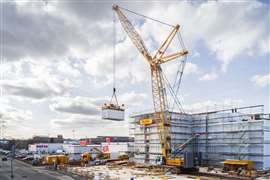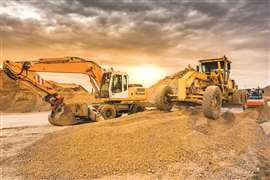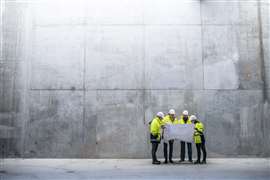Chinese tipping point
22 June 2014
.gif)
Terex AWP, better known by its brand name Genie, has had a presence in China since the mid-1990s. It started out selling big booms to Chinese shipyards, building its business up to a point in 2010 when it opened a dedicated access platform factory in Changzhou.
It is a mark of how far the business has come that today the Changzhou factory is Genie’s global production centre for shipyard booms. On the regional level, it also builds numerous other models for sale throughout Asia-Pacific and of course has a big focus on the potentially huge Chinese market.
Despite a continued slow-down in the Chinese construction market, the ramping-up of production for the wider region has seen big changes over the last year at the 278,000 ft2 (26,000 m2) facility as general manager Clint Weber explained.
“If you were to compare last year to this year, we have brought in 15 models that we are building instead of importing now,” he said. “We’ve had good growth, but it’s not just China. Changzhou supports Asia-Pacific now, so it’s a much bigger piece of the pie.”
This has seen the facility’s workforce swell from 140 staff a year ago to more than 210. But it is not just about more people on the production side. There is also a design capability in Changzhou, and one of the priorities at the moment is to localise the products more to take out costs.
“We have a strategic plan, and the point is that anything we do to take cost out will be imperceptible. We are maintaining the global standard of our machines. If we were to localise a component or weld something in house, it has to pass all the rigours of the Genie Engineering Standards that we have, which are difficult to pass, rightfully so. There are opportunities to take cost out, but we’re not going to go to the lowest of the low.
“It has to be imperceptible. You won’t be able to see the difference between our machines and those made in Redmond (Genie’s home facility in Washington state, US). There might be slightly different components, but those components will be interchangeable. If you have one component and it won’t fit on another machine, then that becomes a different machine. When we’re exporting to Asia-Pacific and the rest of the world, that becomes important,” said Mr Weber.
While the Changzhou plant has come to establish itself as Genie’s regional hub for Asia-Pacific, the big prize is of course China, which is by far the biggest construction equipment market in the world in unit terms. But although staple construction machines like excavators and loaders sell in the hundreds of thousands per year in China, access platforms are far from enjoying the same level of acceptance.
Tipping point
It is a pattern that has been reflected in many countries around the world over the years, and those close to the industry observe that after many patient years of introducing products and educating the market, powered access will take off. This tipping point is just around the corner according to Jim Barr, Terex AWP’s vice president and general manager for Greater China.
“Obviously everybody’s waiting for that exponential growth that happens in new markets. In Korea it happened in 1999, Singapore happened in the early 1990s and Australia happened around 1988. There’s an inflection point and China feels very close to that, at least from my experience in the marketplace,” he said.
One of the curious things about this is that platform sales in China are on the up at the time when the wider construction equipment industry is suffering a third straight year of contraction, following the huge stimulus-spending boom of 2009 to 2011.
Mr Barr acknowledged this. “It’s going from strength to strength, but at the same time we’re cautious. A lot of the key elements in the marketplace are there for that inflection point. A huge project might push it, or a change in safety rules - which is what happened in Brazil and Singapore. There’s going to be something that pushes it over the top.”
He continued, “This is my take on the marketplace. You have construction at the centre and you have three key elements – safety, availability of product and efficiency & productivity. Right now in China, safety is coming. We have a reduction in scaffolding. I don’t see it as being forced – it seems to be organic as more aerial work platforms become available. Social pressure is there and the standard of living is increasing. You see in every emerging market that as the standard of living improves, people are more concerned about safety.
“None of this will happen unless there are affordable products in the marketplace. Contractors need to be able to look at projects and say ‘I’m going to bid this based on 19 ft scissors or 32 ft scissors.’ We have professional rental in place now. They know what they’re doing and they have big enough fleets to support a major project. They can come in with 300 machines.
“The used equipment market is going to develop, and that supports the availability of affordable products. Finance is out there. Rates are affordable – that’s important – in Germany many years ago there were plenty of platforms available but the rates were too high. Now in China the rates are down to a point where the fleet owners don’t like it.”
“The other part is efficiency and productivity – timelines on projects. We have had several projects with a couple of hundred units on them. You seem to reach a point where contractors go onto another project and they want to use aerials because of their previous success. You also have clients that not only want productivity, but also demand safety.”
“Changing ownership patterns are important. China used to be an ownership culture, but now they understand that you can rent it.”
The maturing Chinese market has had an impact on the machines Terex has chosen to build in Changzhou. Although it is the only Genie plant in the world that now makes big booms for shipyards, the volume is coming from scissor lifts, with eight coming off the production line each day.
Sophistication
But the company has learned a few lessons along the way. Some of the early products to come out of Changzhou were under the Skysafe marque, including a push-around scissor lift and non-rotating boom. They are not machines it makes today.
“The Skysafe products were an opportunity for us to go out and focus on the very low end of the market against ladders, scaffolding and even ropes. So we wanted to see if we built a very simple, de-featured product, was there a real clamour for that?
“We found the Chinese market is much more sophisticated than that. If they were going to spend money on an aerial platform, they wanted something that has more to it in terms of value and features.
“What we got out of Skysafe is that we designed, built and did it all in Changzhou, so it was a great dry-run for us, and it also told us where the bottom of the market is. It showed us that the sweet spot is something like a 1532 (15 ft/4.6 m platform height) scissor built in Changzhou that is being costed down. It is not all the way down with products that everyone has like a ladder,” said Mr Barr.
He added, “Changzhou is always looking at what is in our standard product line across the world that could fit in here. For example, another trend in Chinese rental is it is moving more and more to stick booms.”
But a growing market also means growing competition. The other major international players in powered access have factories in China, there are specialist domestic manufacturers, and the expectation is that as volumes become more significant there will be more entrants, including some of the massive Chinese manufacturers.
It is a reality Mr Barr acknowledges. “I think it is a threat, and we’re going to compete. We’re not going to go away. The question is whether they’re going to establish a value proposition with the products that are demanded by the big clients. From our point of view, we have a plant in China that builds world-class products.”
“The value proposition plays into it heavily. If you are an entrepreneur, do you go with experience, or do you go with a new player that’s only been around a couple of years? Some people will want a quick return on their investment and will go with the cheapest product available, but they will never be the guy that supplies the mega projects. There is always a segment that will go after cheap anywhere in the world, and you’ll have that segment here. But I think with safety, efficiency, the understanding of downtime, the overall cost of owning the equipment and residual values, that is where we have 40 years’ experience, and we understand that. But I never dismiss competitors, and I respect them” he said.
So back to the $ 64,000 question, when will the Chinese market take off?
“So many pieces of the puzzle are here today. I think when the government loosens up on the economy, when shipyards come back to full swing, I think there will be opportunities for this market to grow extremely fast. I think every year we have an increase in the rental fleet out there is another year of education for the Chinese market. Not just education on aerials, but education on safety,” said Mr Barr.
And pushed to put a timescale on that, he said, “The inflection point… I could guess… I’d say three to five years.”
STAY CONNECTED


Receive the information you need when you need it through our world-leading magazines, newsletters and daily briefings.
CONNECT WITH THE TEAM











